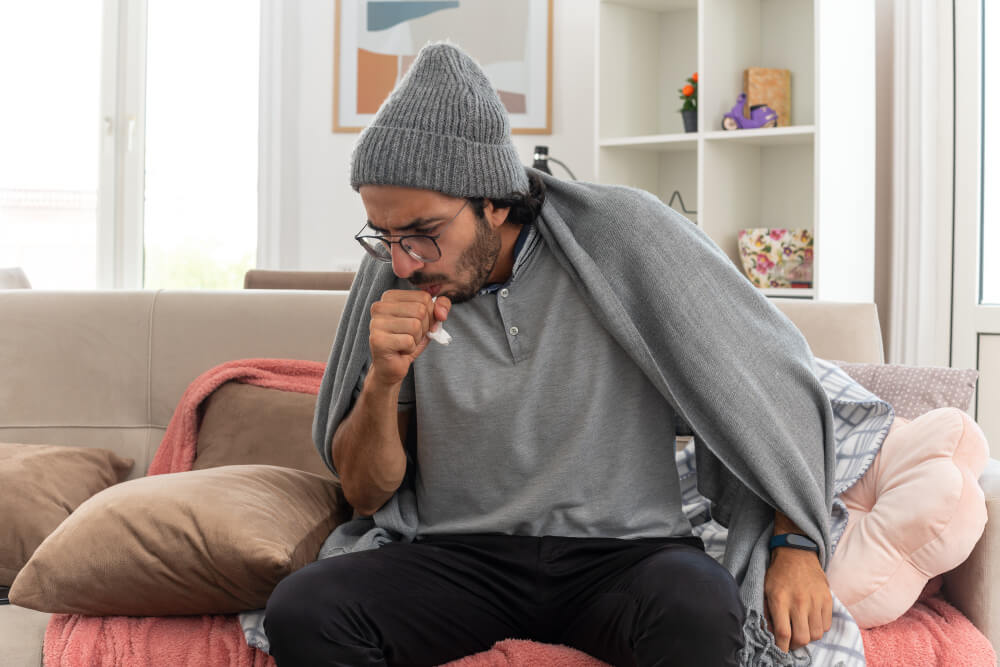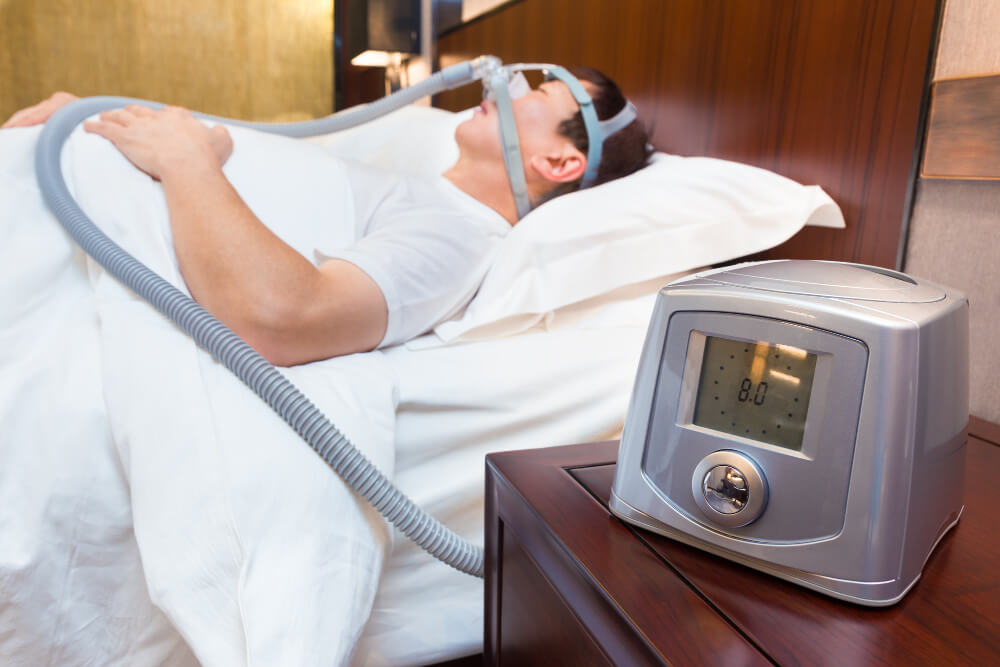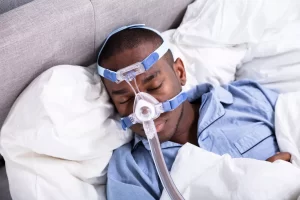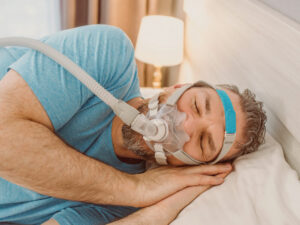For millions struggling with sleep apnea, CPAP machines have become a godsend. These pressurized air devices keep airways open during sleep, preventing the dangerous and disruptive pauses in breathing that characterize the condition.
But as with any medical intervention, long-term CPAP use comes with a potential for side effects. While the benefits of treating sleep apnea far outweigh the risks for most people, it’s important to be informed about the possible downsides of relying on CPAP therapy for years to come.
In this article, we’ll delve into the known long-term side effects of CPAP machine use, separating fact from fiction and empowering you to make informed choices about your sleep health.
Table of Contents
Main Long Term Side Effects of CPAP Machine Use
CPAP Headaches
Morning headaches can occur, possibly due to changes in carbon dioxide and oxygen levels in the blood or due to sinus pressure from the air flow.
Main Causes of CPAP Headaches
- Ill-fitting mask: If your mask is too tight, it can create pressure points and discomfort on your face, leading to headaches. Conversely, a mask that’s too loose may leak air and disrupt your sleep, also contributing to headaches.
- Incorrect pressure settings: Pressure that’s too high can be uncomfortable and cause headaches, while pressure that’s too low might not effectively treat your sleep apnea, leaving you with lingering headaches from sleep disturbance.
- Sinus congestion: The continuous airflow from the CPAP machine can exacerbate existing sinus congestion or irritate your nasal passages, leading to headaches. This can be worse if your pressure settings are too high or humidity levels are low.
- Dryness: The pressurized air from the CPAP machine can dry out your nose and throat, causing irritation and potentially triggering headaches.
Other Contributing Factors:
- Air quality and humidity: Dust, allergens, or mold in the CPAP airflow can irritate your airways and cause headaches. Low humidity can also contribute to nasal dryness and discomfort.
- Changes in sleep patterns: Starting CPAP therapy can disrupt your sleep patterns initially, potentially leading to temporary headaches until your body adjusts.
- Mask and strap material allergies: In rare cases, some people might be allergic to the materials used in the mask or headgear, causing itchy skin and headaches.
How to Prevent and Manage CPAP Headaches
- Talk to your doctor: If you experience persistent headaches, seek guidance from your healthcare provider. They can help identify the cause and recommend solutions.
- Adjust mask and pressure settings: Work with your sleep specialist to ensure your mask fits properly and pressure settings are optimal for comfort and treatment effectiveness.
- Use a humidifier: Add moisture to the air with a heated humidifier to prevent nasal dryness and irritation.
- Keep your equipment clean: Regularly clean your mask, tubing, and humidifier to eliminate allergens and bacteria that could trigger headaches.
- Address underlying sinus issues: If you have chronic sinus problems, seek treatment to reduce congestion and prevent irritation from the CPAP airflow.
- Explore alternative mask styles: If your current mask is uncomfortable, discuss other types with your doctor to find a better fit.
Dry Mouth
Dry mouth occurs when CPAP users breathe through their mouths during sleep. The constant air flow can dry out the oral mucosa, leading to discomfort and potential oral health issues.
What Causes CPAP Dry Mouth
- Mouth Breathing: If you breathe through your mouth while sleeping, CPAP therapy can exacerbate dry mouth. This is particularly true if you use a nasal mask or nasal pillows, as they do not prevent air from escaping through your mouth.
- Leakage from the Mask: If your CPAP mask does not fit properly, air can leak out, leading to dry mouth. This is often the case with full-face masks that cover both the nose and mouth but can also occur with other types of masks.
- Inadequate Humidification: CPAP machines often come with a built-in or attachable humidifier. If the humidification level is too low, the air can be dry, which in turn dries out your mouth and nasal passages.
- High CPAP Pressure Settings: Higher pressure settings on your CPAP machine can increase the likelihood of air leaking from your mouth, especially if you’re using a nasal mask or nasal pillows.
- Medications or Other Health Conditions: Certain medications or health conditions can contribute to dry mouth. For example, medications for depression, anxiety, and high blood pressure often have dry mouth as a side effect.
- Dehydration: Not consuming enough fluids during the day can lead to dehydration, which can be exacerbated by the use of a CPAP machine at night.
- Room Environment: Environmental factors like a dry or hot room can also contribute to dry mouth during CPAP therapy.
How to Manage CPAP Dry Mouth
- Switch to a Full-Face Mask: If you are a mouth breather, a full-face mask that covers both your nose and mouth might help.
- Use a Chin Strap: A chin strap can help keep your mouth closed during sleep, reducing air leakage.
- Adjust Humidifier Settings: Increase the humidity level on your CPAP machine to add moisture to the air you breathe.
- Check and Adjust CPAP Pressure: Consult with your healthcare provider to see if adjusting the pressure settings could help.
- Stay Hydrated: Ensure you are drinking enough water throughout the day.
- Room Humidifier: Using a room humidifier can add moisture to the air in your bedroom.
Dry Eyes
This side effect is often due to air leaks from an ill-fitting mask, directing air into the eyes. It can cause irritation, redness, and a feeling of dryness in the eyes.
Causes of CPAP Dry Eyes
- Air Leak from the Mask: If your CPAP mask does not fit properly, air can leak out and blow into your eyes. This is particularly common with full-face masks or nasal masks that are not properly adjusted. The constant stream of air can dry out the eyes.
- Sleeping with Eyes Partially Open: Some people naturally sleep with their eyes slightly open, a condition known as nocturnal lagophthalmos. The use of a CPAP machine can exacerbate dryness in these cases, as the air flow can increase evaporation of tears from the exposed part of the eyes.
- Room Environment: Environmental factors such as a dry or air-conditioned room can contribute to dry eyes, and the use of a CPAP machine might worsen this condition.
- Humidification Levels: If your CPAP machine has a humidifier and it’s not set to an adequate level, or if you are not using a humidifier at all, the air you breathe can be dry. This dry air, in turn, can contribute to dry eyes, especially if there’s an air leak from the mask.
- Type of Mask: The type of CPAP mask you use can play a role. Nasal pillows, which fit directly into the nostrils, can sometimes lead to more air leakage towards the eyes compared to a well-fitted full-face mask.
- Pressure Settings: Higher pressure settings on your CPAP machine can increase the likelihood of air leakage, which can lead to dry eyes.
How to Manage CPAP Dry Eyes
- Ensure Proper Mask Fit: Make sure your mask fits well to minimize air leaks. A well-fitting mask is crucial in preventing air from blowing into your eyes.
- Use a CPAP Mask with a Better Seal: Consider trying different types of masks that offer a better seal and fit for your face.
- Adjust Humidifier Settings: If your CPAP machine has a humidifier, adjust it to increase the moisture in the air you breathe.
- Eye Protection: Some people find relief by wearing a sleep mask or special goggles designed to protect the eyes from air leaks during sleep.
- Consult with a Specialist: If you continue to experience dry eyes despite making these adjustments, consult with a healthcare provider or a sleep specialist. They can help you adjust your CPAP settings or recommend alternative treatment options.
- Lubricating Eye Drops: Using lubricating eye drops before bedtime can help alleviate dryness. Be sure to use eye drops that are suitable for nighttime use and are preservative-free.
Nasal Congestion
The continuous air flow from the CPAP machine can dry out and irritate the nasal passages, leading to congestion. This might require additional humidification or nasal sprays.
What Causes CPAP Nasal Congestion
- Dry Air: CPAP machines can sometimes deliver air that is too dry for your nasal passages. This dry air can irritate the mucous membranes in your nose, leading to swelling and congestion.
- Allergies or Irritants: If you’re allergic to any component of the CPAP mask or if the mask or tubing isn’t cleaned properly, it can lead to allergic reactions or irritation, causing nasal congestion.
- Humidity Levels: Both too much and too little humidity can cause problems. Low humidity can dry out your nasal passages, while high humidity can make your nose feel stuffy.
- Pressure Settings: If the pressure setting on your CPAP machine is too high, it can lead to discomfort and swelling in the nasal passages. Conversely, if the pressure is too low, it might not be enough to keep your airway open, leading to snoring and congestion.
- Sinus Issues: Individuals with pre-existing sinus issues, such as chronic sinusitis or nasal polyps, may find that CPAP use exacerbates their nasal congestion.
- Temperature: The temperature of the air can also affect nasal congestion. Air that is too cold can irritate the nasal passages.
- Mouth Breathing: If you are using a nasal mask or nasal pillows and you breathe through your mouth, your nasal passages may become dry and irritated, leading to congestion.
- Sleep Position: Your sleeping position can influence nasal congestion. Sleeping on your back, for instance, can worsen congestion due to gravity’s effect on your airways.
How to Manage CPAP Nasal Congestion
To alleviate CPAP-induced nasal congestion, consider the following strategies:
- Use a Heated Humidifier: Most modern CPAP machines come with a heated humidifier which can add moisture to the air, preventing dryness.
- Adjust the Humidity Level: Experiment with different humidity levels to find what works best for you.
- Check and Adjust Pressure Settings: Consult with your healthcare provider to ensure your CPAP pressure settings are optimal.
- Nasal Saline Sprays: Using a saline nasal spray before bedtime can help keep your nasal passages moist.
- CPAP Mask Fit: Ensure your mask fits well. A poorly fitting mask can exacerbate breathing and congestion issues.
- Regular Cleaning: Keep your CPAP equipment clean to avoid the buildup of allergens and irritants.
- Consider a Full-Face Mask: If you’re a mouth breather, a full-face mask might be more appropriate.
CPAP Cough
CPAP cough is one of the worst side effects of using a CPAP machine, but, if you understand what causes it and how to prevent it, you can still use your favorite sleep apnea treatment safely and comfortably.

What Causes CPAP Cough
- Dry Air: CPAP machines can sometimes deliver air that is too dry, which can irritate your airways and throat, leading to coughing. This is particularly common in environments with low humidity or if the CPAP machine doesn’t have a humidifier.
- Humidifier Settings: If your CPAP machine has a humidifier and it’s not adjusted correctly (either too high or too low), it can cause issues. Too much humidity can create condensation in the mask or tubing, while too little can dry out your airways.
- Allergies or Sensitivities: Some people may be allergic or sensitive to the materials used in CPAP masks or hoses. Additionally, if the equipment is not cleaned regularly, it can harbor allergens like dust mites or mold.
- Postnasal Drip: CPAP therapy can sometimes exacerbate or induce postnasal drip, especially if you have pre-existing sinus issues. This drip can irritate the throat and lead to coughing.
- Gastroesophageal Reflux Disease (GERD): CPAP therapy can increase the pressure inside the chest and abdomen, potentially worsening GERD symptoms. Acid reflux can irritate the throat and airways, leading to coughing.
- Infection: If your CPAP equipment is not cleaned properly, it can become a breeding ground for bacteria or viruses, potentially leading to respiratory infections and coughing.
- Air Pressure Settings: If the air pressure settings on your CPAP machine are too high, it can lead to discomfort and coughing. Conversely, if the pressure is too low, it might not prevent apnea events effectively, which can also cause coughing.
- Lung Conditions: Pre-existing lung conditions, such as asthma or chronic obstructive pulmonary disease (COPD), can be exacerbated by CPAP use, leading to coughing.
How to Prevent and Manage CPAP Cough
- Humidification: Use a CPAP machine with a humidifier and adjust the settings to find a comfortable level of humidity.
- Regular Cleaning: Clean your CPAP equipment regularly to prevent the buildup of allergens and germs.
- Check the Mask Fit: Ensure your CPAP mask fits properly to prevent air leaks that can dry out your throat and nose.
- Consult with a Healthcare Provider: If coughing persists, consult with your healthcare provider. They can check for other underlying causes and suggest appropriate modifications to your CPAP therapy or other treatments.
- Adjust Pressure Settings: Have your CPAP pressure settings evaluated and adjusted if necessary.
- Manage GERD: If you have symptoms of acid reflux, managing GERD through diet, lifestyle changes, or medication can help reduce coughing.
- Allergy Management: If allergies are suspected, consider allergy testing and management strategies.
Skin Irritations
The mask and straps can cause pressure sores, acne, or skin irritation, particularly if the mask is too tight or if the user has sensitive skin.
Causes of CPAP Skin Irritation
CPAP skin irritation can be a frustrating side effect of therapy, but several culprits can be behind it:
- Mask Fit: A poorly fitting mask rubs against your skin, causing chafing and redness. Masks that are too tight dig in, leaving marks and pressure sores. Seek a proper fit, adjusting straps or considering different mask styles.
- Hygiene: Dirty masks and cushions harbor bacteria and irritants. Clean your mask daily with mild soap and water, and thoroughly dry it. Wash your face before bed to remove oils that can cause the mask to slide.
- Mask Materials: Some people have sensitivities to silicone, the common mask material. Consider masks with different materials like fabric or gel, or consult your doctor about testing for allergies.
- Moisture Overload: Humidifiers can inadvertently shower your face, leading to redness and breakouts. Adjust humidity settings, ensure proper hose insulation, and avoid overfilling the humidifier.
- Friction and Movement: Facial hair can disrupt the mask seal, causing rubbing and irritation. Trimming or shaving may help. Additionally, oily skin or vigorous sleep movements can contribute to friction.
- Underlying Skin Conditions: If you have a pre-existing skin condition like eczema or dermatitis, CPAP use can exacerbate it. Consult your doctor for advice on managing both conditions simultaneously.
How to Prevent CPAP Skin Irritation
- Ensure Proper Fit: Make sure your CPAP mask fits correctly. A mask that is too tight can cause pressure sores, while a mask that is too loose can rub against the skin. Consult with your healthcare provider to ensure you have the right size and style of mask for your face shape.
- Clean Your Equipment Regularly: Daily cleaning of your CPAP mask, tubing, and humidifier is crucial. Dirt, oils, and sweat can accumulate on the mask, leading to skin irritation. Use mild soap and warm water or wipes specifically designed for CPAP masks.
- Use Mask Liners: Mask liners are soft cloth barriers that sit between your mask and your skin. They can help reduce irritation and the buildup of oils and sweat on the mask.
- Moisturize Your Skin: Applying a non-oily, fragrance-free moisturizer on your face before putting on the CPAP mask can help protect your skin. However, avoid petroleum-based products as they can degrade the mask.
- Take Breaks: If possible, take short breaks from using your CPAP machine during the day to allow your skin to breathe.
- Adjust Humidity Levels: If your CPAP machine has a humidifier, adjust the humidity level to a comfortable setting. Too much or too little humidity can cause skin problems.
- Change Cushions and Straps: Over time, the cushions and straps of the mask can wear out, leading to poor fit and increased friction against the skin. Replace them as recommended by the manufacturer or your healthcare provider.
- Use Barrier Creams: In some cases, barrier creams can be applied to the areas where the mask contacts the skin. These creams can provide a protective layer between the mask and your skin.
- Check for Allergies: Some people may be allergic to the materials used in CPAP masks. If you suspect an allergy, consult with your healthcare provider. Hypoallergenic mask options are available.
- Consult a Professional: If skin irritation persists, consult with your healthcare provider. They may suggest a different type of mask or adjustments to your CPAP therapy.
Ear Discomfort
Changes in air pressure can sometimes lead to discomfort or pain in the ears, similar to what one might experience during air travel.
What Causes CPAP Ear Discomfort
- Pressure Changes: The most common cause of ear discomfort with CPAP use is the pressure difference between the middle ear and the outside environment. This can happen when the CPAP machine forces air into the airway and creates an imbalance in ear pressure.
- Eustachian Tube Dysfunction: The Eustachian tubes help equalize pressure between the middle ear and the throat. If these tubes are blocked or not functioning properly, using a CPAP machine can exacerbate the problem, leading to discomfort or pain.
- Rapid Increase in CPAP Pressure: If the CPAP machine is set to rapidly increase to the therapeutic pressure, it might not allow enough time for the ears to adjust to the pressure changes, causing discomfort.
- Allergies or Sinus Issues: Allergies, colds, or sinus infections can lead to congestion and blockage of the Eustachian tubes, which can be aggravated by the use of a CPAP machine.
- Incorrect Mask Fit: An improperly fitted mask can lead to uneven pressure distribution, which might indirectly affect ear pressure.
- Sleep Position: Certain sleeping positions may affect how pressure is distributed and can impact the ears.
- Pre-existing Ear Conditions: Individuals with pre-existing conditions such as chronic ear infections or a history of ear surgery may be more sensitive to pressure changes caused by CPAP therapy.
How to Manage CPAP Ear Discomfort
- Consult with a Healthcare Provider: They can check for any underlying issues like Eustachian tube dysfunction or sinus problems and suggest appropriate treatments.
- Adjust CPAP Settings: Your healthcare provider might adjust the pressure settings or recommend a machine with a ‘ramp’ feature that gradually increases pressure.
- Check Mask Fit: Ensure your CPAP mask fits well and is properly adjusted.
- Use Nasal Sprays or Decongestants: If allergies or sinus issues are contributing to the problem, nasal sprays or decongestants might help, but consult with a healthcare provider before using them.
- Practice Eustachian Tube Exercises: Simple exercises like swallowing, yawning, or the Valsalva maneuver can help equalize ear pressure.
- Change Sleeping Positions: Experiment with different sleeping positions to find one that reduces ear discomfort.
Claustrophobia
Wearing a CPAP mask, especially full-face masks, can induce feelings of claustrophobia in some users, often requiring gradual acclimatization or alternative mask types.
Causes of CPAP Claustrophobia
- Mask Size and Fit: A CPAP mask that is too tight, too large, or poorly fitted can create a sense of being trapped or smothered. This is particularly true for full-face masks that cover both the nose and mouth.
- Air Pressure Sensation: The sensation of constant air pressure, especially if it’s set too high, can cause discomfort and a feeling of breathlessness, which can trigger claustrophobic reactions.
- Lack of Familiarity: For new users, the sensation of wearing a CPAP mask can be strange and uncomfortable. This unfamiliarity can contribute to feelings of anxiety and claustrophobia.
- Pre-existing Claustrophobia: Individuals who already have claustrophobic tendencies may find it more challenging to adapt to wearing a CPAP mask.
- Limited Mobility: Being connected to a CPAP machine can restrict movement during sleep, which can induce feelings of being trapped or confined.
- Psychological Factors: Anxiety, panic disorders, and other psychological conditions can exacerbate feelings of claustrophobia when using a CPAP machine.
- Physical Discomfort: Discomfort caused by the mask’s straps, the weight of the mask, or the feeling of the mask against the skin can contribute to claustrophobic feelings.
- Nasal Congestion: If the CPAP machine exacerbates nasal congestion, it can make breathing feel more difficult, thereby increasing feelings of claustrophobia.
- Noise of the Machine: For some individuals, the noise produced by the CPAP machine, although generally quiet, can be a source of discomfort and anxiety.
- Environmental Factors: The sleeping environment, such as a small or poorly ventilated room, can also contribute to feelings of claustrophobia.
How to Manage CPAP Claustrophobia
Managing CPAP claustrophobia involves a combination of practical adjustments to the CPAP equipment, behavioral strategies, and sometimes psychological support. Here are some effective ways to manage this issue:
- Gradual Acclimatization: Start by wearing the CPAP mask for short periods while awake. Gradually increase the time you wear it each day to get used to the sensation.
- Mask Fitting and Selection: Ensure your CPAP mask fits correctly. A mask that is too tight or too loose can increase anxiety. There are different types of masks (nasal pillows, nasal masks, full-face masks), so trying different styles to find the most comfortable one is key.
- Desensitization Techniques: Practice relaxation techniques such as deep breathing or progressive muscle relaxation while wearing the mask. This can help reduce anxiety associated with the mask.
- Adjust CPAP Settings: Work with your healthcare provider to adjust the CPAP machine settings. Some machines have a “ramp” feature that gradually increases air pressure, making it easier to adapt to.
- Create a Comfortable Environment: Make your sleeping area comfortable and calming. This can include using a comfortable mattress, maintaining a cool room temperature, and reducing noise.
- Cognitive Behavioral Therapy (CBT): For some, claustrophobia is linked to anxiety or panic disorders. CBT, a type of psychotherapy, can be very effective in managing these conditions.
- Distraction Techniques: Use distractions like listening to music, audiobooks, or white noise while falling asleep with the CPAP mask on.
- Practice Good Sleep Hygiene: Establish a regular sleep schedule, avoid caffeine and alcohol before bedtime, and create a bedtime routine to improve overall sleep quality.
- Consult a Specialist: If claustrophobia persists, consult a sleep specialist or a psychologist. They can provide tailored strategies and support.
- Peer Support: Joining a support group for CPAP users can provide helpful tips and emotional support from others who have experienced similar challenges.
- Nasal Sprays or Decongestants: If nasal congestion is a problem, over-the-counter nasal sprays or decongestants might help, but consult with a healthcare provider before using them.
Aerophagia
This is the ingestion of air during CPAP use, which can lead to bloating, stomach pain, or gas. It’s more common in users with higher pressure settings.
What Causes CPAP Aerophagia
- High Air Pressure Settings: If the CPAP machine is set to a pressure that is too high for the user’s needs, it can lead to excess air being pushed into the esophagus and stomach.
- Mask Fit and Type: An ill-fitting mask can cause the user to open their mouth during sleep, increasing the likelihood of swallowing air. The type of mask (nasal pillows, nasal mask, or full-face mask) can also play a role.
- Sleep Position: Certain sleeping positions, like sleeping on your back, can make it easier for air to enter the esophagus rather than the airway.
- Rapid Breathing or Mouth Breathing: If a person breathes rapidly or primarily through their mouth while using CPAP, they may be more likely to swallow air.
- Existing Gastrointestinal Issues: Individuals with existing gastrointestinal conditions such as acid reflux or hiatal hernia may be more prone to aerophagia.
- Inadequate Acclimatization: Some people may experience aerophagia as they are getting used to CPAP therapy, especially if they start with a high pressure setting.
- Respiratory Rate and CPAP Compatibility: If the CPAP machine’s airflow does not synchronize well with the user’s natural breathing pattern, it can lead to swallowing air.
How to Prevent CPAP Aerophagia
- Adjust CPAP Settings: Consult with your healthcare provider to adjust the air pressure settings on your CPAP machine. Often, aerophagia is caused by too high a pressure setting.
- Use a BiPAP Machine: If adjusting the CPAP settings doesn’t help, your doctor might recommend switching to a BiPAP (Bilevel Positive Airway Pressure) machine. BiPAP provides two levels of pressure – lower pressure when you exhale and higher pressure when you inhale – which can reduce the risk of swallowing air.
- Ensure Proper Mask Fit: Make sure your CPAP mask fits well. A mask that is too loose can cause you to open your mouth during sleep, increasing the likelihood of swallowing air. There are different types of masks (nasal pillows, nasal masks, full-face masks), so finding the right one for your face shape and sleep habits is important.
- Consider a Chin Strap: If you tend to sleep with your mouth open, a chin strap can help keep your mouth closed and reduce the chance of swallowing air.
- Change Sleeping Positions: Sleeping on your back can sometimes increase the likelihood of aerophagia. Try sleeping on your side to see if it reduces the problem.
- Gradual Acclimatization: If you’re new to CPAP therapy, start with a lower pressure setting and gradually increase it as you get used to the machine. This can help your body adjust to the therapy.
Other Side Effects of CPAP Use
- Tooth Movement or Bite Changes – In rare cases, the pressure exerted by the mask straps over a prolonged period can lead to movement in the teeth or changes in the bite.
- Eye Irritation or Infections – Air leaks directed towards the eyes can cause dryness, irritation, and an increased risk of infections like conjunctivitis.
- Sinus Infections – The drying effect of the CPAP air flow can irritate the sinus passages, potentially leading to increased susceptibility to sinus infections.
- Respiratory Infections – If the CPAP machine and mask are not cleaned properly, there’s a risk of respiratory infections due to the buildup of bacteria or mold.
- Discomfort in Chest Muscles – Some users may experience discomfort or a feeling of pressure against their chest muscles, particularly when adjusting to the CPAP therapy or at higher pressure settings.
- Tolerance Issues – Over time, some individuals might find it increasingly difficult to tolerate the sensation or noise of CPAP therapy, leading to reduced compliance.
- Dependence on Machine for Sleep – Long-term CPAP users might become psychologically or physically dependent on the machine for sleep, feeling unable to sleep without it.
- Weight Gain – There is some evidence suggesting a potential link between CPAP use and weight gain, although this correlation is not conclusively proven and may involve other factors.
- Dental Issues – Prolonged CPAP use can sometimes lead to dental issues, especially if the mask affects the alignment of the jaw or puts pressure on the teeth.
- Increased Pressure on the Lungs – The constant air pressure, especially at higher settings, can sometimes feel uncomfortable for the lungs, leading to a sensation of difficulty in breathing.
- Difficulty Exhaling – Exhaling against the incoming air pressure can be challenging for some CPAP users, often requiring adjustments in machine settings or the use of a bilevel device.
- Nosebleeds – Nosebleeds, or epistaxis, can occur due to the drying effect of the air flow on the delicate nasal membranes, especially in users with higher air pressure settings.
- Reduced Intimacy – Wearing a CPAP mask can impact physical closeness and intimacy with a partner, often requiring open communication and adjustment.
- Psychological Effects – The need for a CPAP machine can impact self-image and lead to feelings of anxiety or embarrassment, which may require psychological support or counseling.
Each of these side effects varies in frequency and intensity among CPAP users, and many can be managed effectively with the help of healthcare professionals. The overall benefits of CPAP therapy in treating obstructive sleep apnea typically outweigh these potential side effects.




